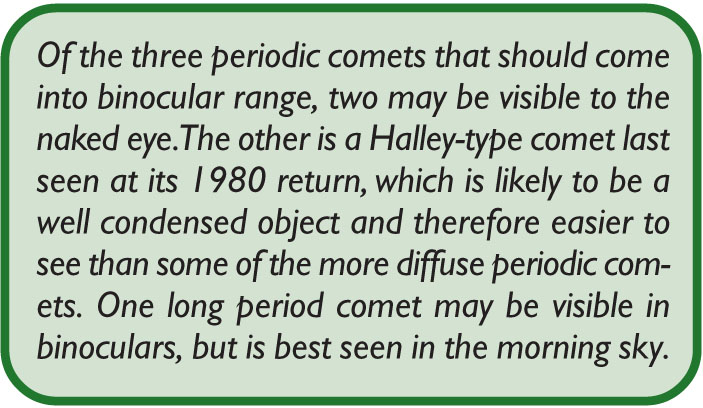Comet prospects for 2018
2017 November 18
 These predictions focus on comets that are likely to be within range of visual observers, though comets often do not behave as expected and can spring surprises. Members are encouraged to make visual magnitude estimates, particularly of periodic comets, as long term monitoring over many returns helps understand their evolution. Please submit your magnitude estimates in ICQ format. Guidance on visual observation and how to submit estimates is given in the BAA Observing Guide to Comets. Drawings are also useful, as the human eye can sometimes discern features that initially elude electronic devices.
These predictions focus on comets that are likely to be within range of visual observers, though comets often do not behave as expected and can spring surprises. Members are encouraged to make visual magnitude estimates, particularly of periodic comets, as long term monitoring over many returns helps understand their evolution. Please submit your magnitude estimates in ICQ format. Guidance on visual observation and how to submit estimates is given in the BAA Observing Guide to Comets. Drawings are also useful, as the human eye can sometimes discern features that initially elude electronic devices.
Theories on the structure of comets suggest that any comet could fragment at any time, so it is worth keeping an eye on some of the fainter comets, which are often ignored.
They would make useful targets for those making electronic observations, especially those with time on instruments such as the Faulkes telescopes. Such observers are encouraged to report electronic visual equivalent magnitude estimates via COBS. When possible use a waveband approximating to Visual or V magnitudes. These estimates can be used to extend the visual lightcurves, and hence derive more accurate absolute magnitudes. Such observations of periodic comets are particularly valuable as observations over many returns allow investigation into the evolution of comets.
In addition to the information in the BAA Handbook and on the Comet Section web pages, ephemerides for new and currently observable comets are on the JPL, CBAT and Seiichi Yoshida’s websites. The BAA Observing Guide to Comets is available on the Section web page: https://britastro.org/node/6817.
21P/Giacobini-Zinner is the parent comet of the October Draconid meteors. On this return no significant activity from dust trail encounters is expected. The comet was first discovered by Michael Giacobini at Nice observatory in 1900 December and was thought to have a period of 6.8 years. The next two returns were expected to be difficult to observe, but in 1913 October, Ernst Zinner, of Bamberg, Germany, discovered a comet whilst observing variable stars in Scutum. This turned out to be the same comet, but the period had been incorrectly determined and was actually 6.5 years… (continued)
Login or click above to view the full article in PDF format)
| The British Astronomical Association supports amateur astronomers around the UK and the rest of the world. Find out more about the BAA or join us. |
